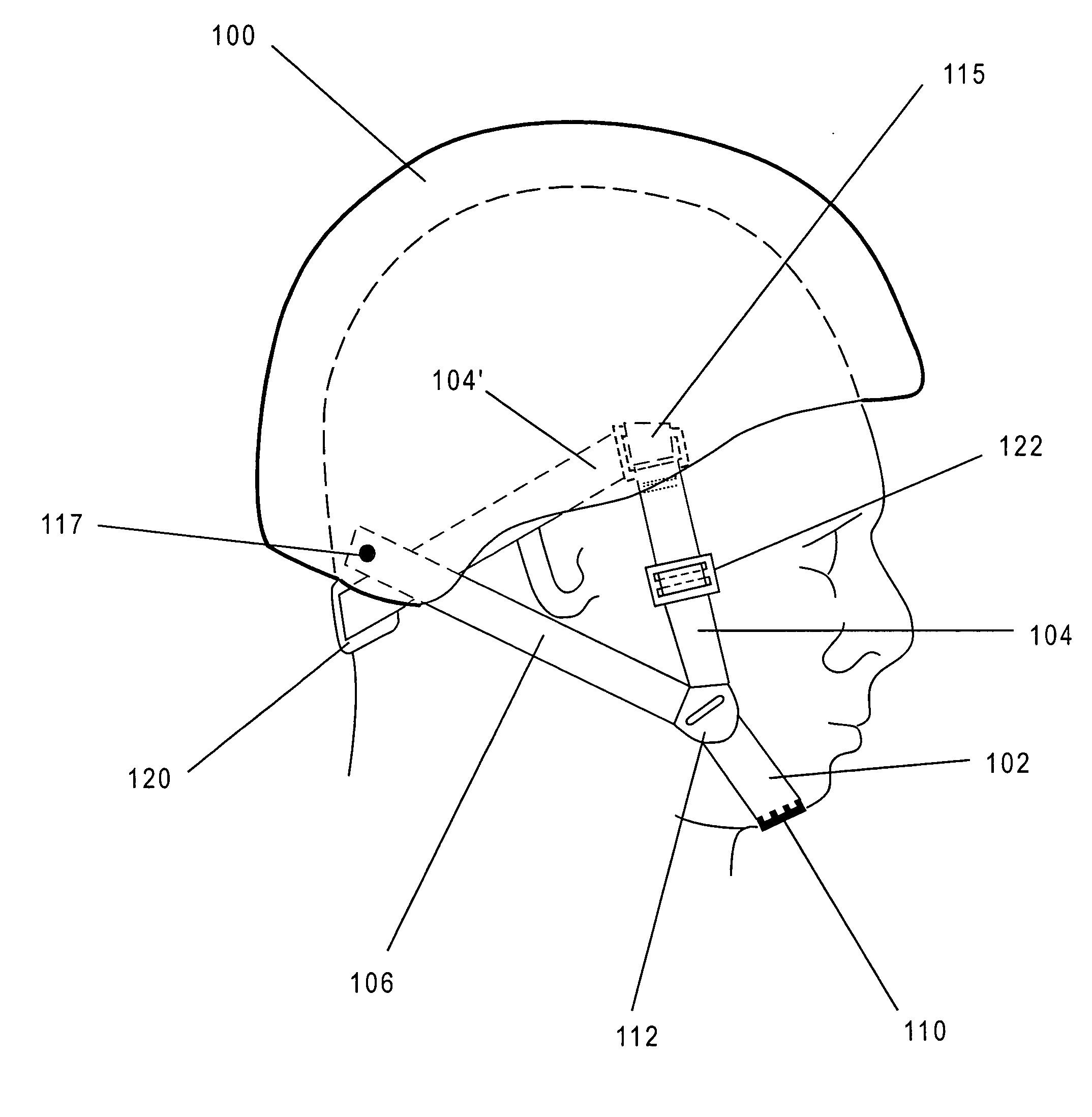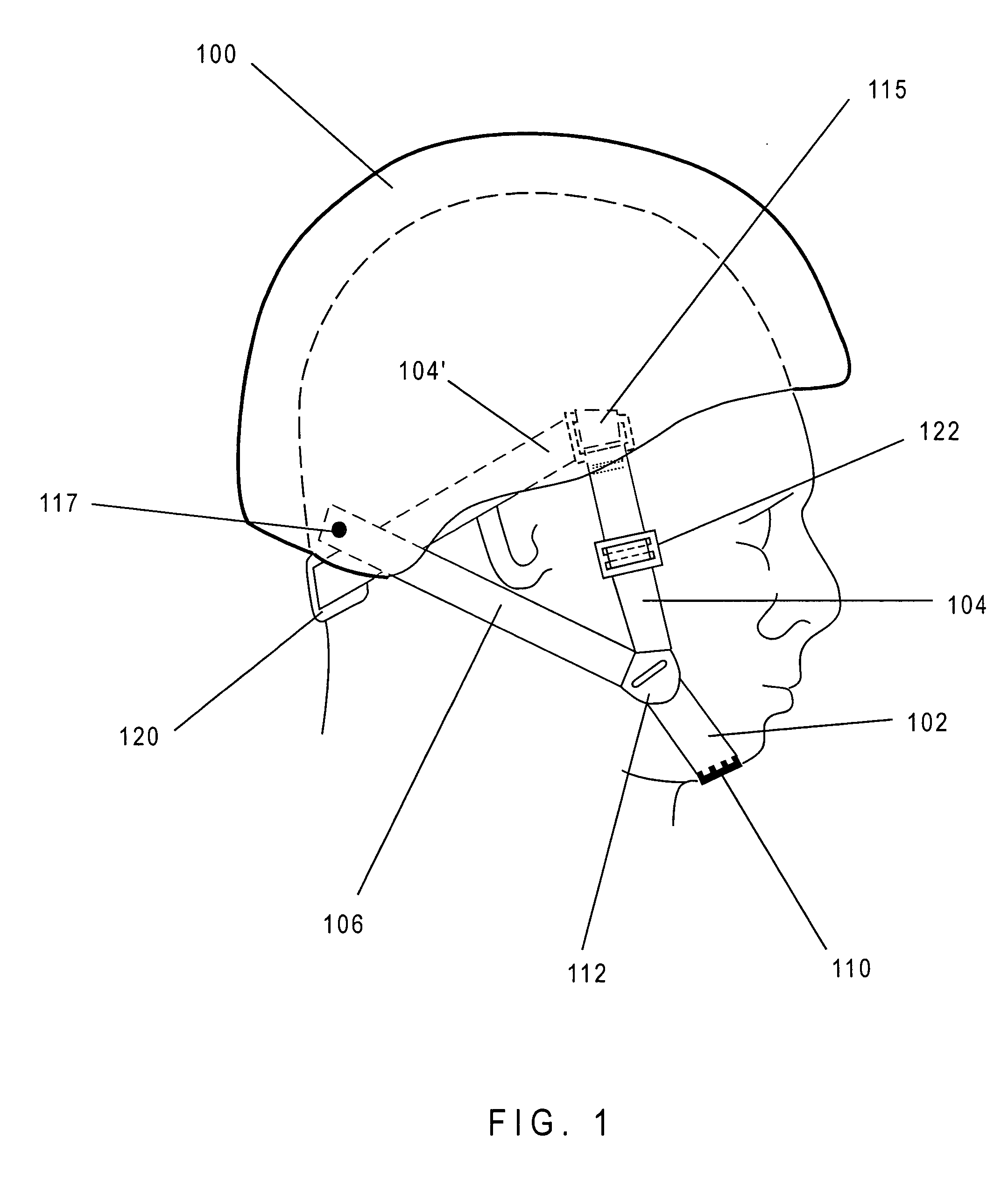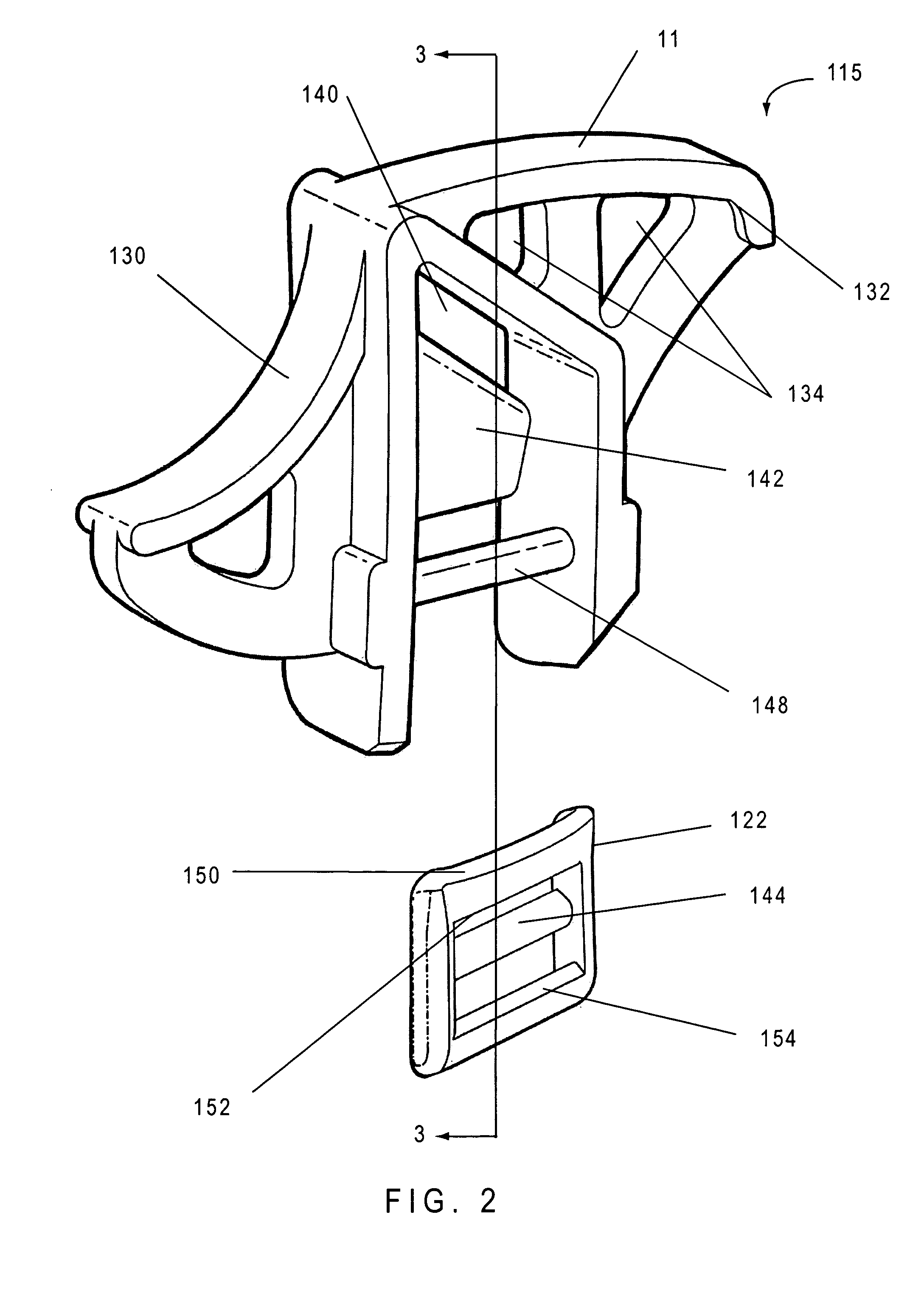[0008] In using a helmet in accordance with the present invention, the chinstrap is adjusted once to fit the size and shape of the wearer's head. This is done by placing the helmet in position as described below and adjusting the length of the straps by conventional adjusting means, e.g., a friction or toothed buckle. An
advantage of the present invention is that the chinstrap works equally well secured at or below the
chin. Repeat use of the helmet by the same wearer requires no further adjustment. When the helmet is to be put on, the straps coming from the opposite sides of the helmet are open and there is no tension on the head-retention element. The wearer places the helmet on his / her head. The wearer then takes each strap in his / her corresponding hand, pulls downward, and attaches them at the
chin. This
pulling action slides the strap within the attachment mechanism and tightens the head-retention element at the back of the neck. Hence the familiar action of securing the helmet against upward forces with the chinstrap also tightens the head-retention element to secure the helmet against rotation (particularly front-to-back rotation).
[0009] The ensuing discussion focuses on the geometry of a two-point “Y” retention strap in accordance with the invention, but it will be appreciated that this represents only one embodiment of the invention, which is amenable to numerous configurations—e.g., in conjunction with a full helmet having only a single retention strap. The retention straps are similar and symmetrical on opposite sides of the helmet, coming to a point of contact at the wearer's chin and joined by a clip or other releasable attachment device known in the art. The geometry of the retention straps on each side is in the form of a “Y.” The middle
junction point of the “Y” is fixed by a clip or by sewing the straps together such that they can flex, but cannot slide relative to one another. The strap that passes behind the wearer's ear is secured to the helmet by conventional means and holds the rear of the helmet against the wearers head. In a full helmet with only one strap, the rear strap is not needed as the material of the helmet shell itself rigidly attaches the rear of the helmet to the point where a single strap can provide a downward force. This single strap, or in the case of the “Y” configuration, the strap that passes in front of the wearer's ear, is routed through the attachment mechanism of the present invention to provide two functions: first, it secures the helmet downwardly against the wearer's head; and second, it passes through the attachment mechanism and then back to an attachment point on the head-retention element. When the chinstrap is pulled, a portion of it slides within the attachment mechanism and pulls the head-retention element forward and upward, pressing it against the nape of the wearer's neck. When the chinstrap is fastened at the neck or chin, the combination of the forward and upward tension on the head-retention element and the downward tension on the helmet shell provides a secure fit.
[0010] The attachment mechanism is secured to (or integral with) the side of the helmet shell. For example, the attachment mechanism may be co-molded with the plastic of the outer shell, or may instead be mechanically secured by
rivet, bolt, or other conventional attachment means. The attachment mechanism provides a path for one member of the chinstrap to slide as its path changes direction from upward to rearward. This is accomplished by surfaces within the attachment mechanism that guide the sides of the strap, and a smooth rounded surface over which the strap slides. The attachment mechanism also provides a latching function that secures the helmet downwardly once the chinstraps have been joined. In a preferred embodiment, this latching function is provided by a parallel strap that rides over and frictionally secures the main or head-retention strap at the attachment mechanism. In another embodiment, latching is accomplished by means of a pinching action that frictionally engages the strap (e.g., by means of angular elements such as teeth or a pin acutely angled against the strap) when it is pulled downward and attached at the chin. In yet another embodiment, latching is accomplished by a movable element that binds against the strap after it has been adjusted by pulling downwardly. Any of these embodiments or their equivalents function to secure the helmet in the downward direction. (Were the latching mechanism not present, the strap that tightens the head-retention element could slide in either direction. Thus, if an upward force were applied to the rear of the helmet, the strap could slide back, loosening the head-retention element and allowing the helmet to pivot forward, becoming dislodged from the wearer's head.)
[0011] In a first aspect, therefore, the invention, comprises a safety helmet that includes a body configured to receive a wearer's head, a chinstrap, and a rear head-retention element responsive to the chinstrap such that tightening of the chinstrap draws the head-retention element in both forward and upward directions. In some embodiments, the body comprises a crown portion, a forward portion, a rear portion, and a cavity for receiving the wearer's head, and the head-retention element is located within the cavity at the rear portion of the helmet; in this way, tightening of the chinstrap draws the head-retention element toward both the crown portion and the forward portion. The head-retention element may comprise a stabilizer configured to engage the rear of the wearer's head. In some embodiments, the stabilizer is engaged by a stabilizer strap mechanically continuous with the chinstrap. In other embodiments, the stabilizer is engaged by a stabilizer strap frictionally engaging the chinstrap. The chinstrap and the stabilizer strap may be a single continuous strap, or may instead comprise multiple straps in a Y configuration. In preferred embodiments, tightening of the chinstrap places tension on the stabilizer strap that resists relaxation despite release of the chinstrap. The tension may be maintained, for example, by a latch.
[0012] In another aspect, the invention comprises a method of securing a safety helmet. The method comprises the steps of providing a safety helmet comprising a body configured to receive a wearer's head, a chinstrap, and a rear head-retention element, and, with the wearer's head within the body, tightening the chinstrap so as to draw the head-retention element in both forward and upward directions, thereby securing the safety helmet.
 Login to View More
Login to View More  Login to View More
Login to View More 


